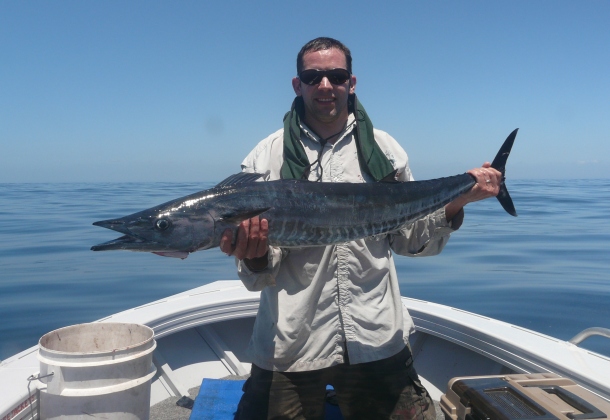WAHOO (Acanthocybium solandri) are unique tropical oceanic speedsters. Their body shape hints at their close taxonomic relationship to mackerels and tunas, but leaving appearances aside, to say these piscatorial hot rods live life in the fast lane is an understatement.
Some of the earliest scientific studies of wahoo as far back as the 1960s found that they are amongst the fastest things with fins. Using modified fishing gear for measurements, a little 113 cm wahoo was timed at 77 km/h, or over 21 metres a second. This suggests that with a growth potential of over 2.1 metres and 83 kg, large wahoo can probably reach or even exceed a burst speed of over 100 km/h, a mark which can be exceeded only by much larger fish such as sailfish or other billfish.
More recent studies by Australian researchers have confirmed that the wahoo’s speedy tendencies are not only restricted to its swimming ability. Researchers from the University of Queensland have recently studied the biology and growth of wahoo from the Coral Sea and Australia’s east coast, confirming they are amongst the fastest growing fishes on the planet. They found that the specific growth rate of wahoo (measured in mm of fork length per day) in their first year of life in the Coral Sea was between 1 and 3.7 mm per day, the latter being a phenomenal growth rate matched only by mahi mahi and the much larger striped marlin.
Of course there was evidence that growth rate varied between individual fish as well as in different regions (probably related to food availablility), but on average, wahoo over 3 months old were growing at over 2 mm per day during their first year in the Coral Sea.
Not only do wahoo in the Coral Sea grow fast, the researchers also found that they mature early, with 50 per cent of female fish maturing at a fork length of between 1 and 1.1 metres long before they were a year old!
Indeed, the researchers did not collect any wahoo less than 79 cm long off Australia’s east coast, but fortunately they were gifted three fish less than 60 cm long taken in the eastern Pacific Ocean, which provided valuable additional data to assist with plotting their growth curves. Closer study of otoliths (ear bones) found fastest growth occurred during the winter months, with growth slowing down during the protracted summer spawning season between October and February.
The slowing of growth during the spawning season is to be expected when you consider they found evidence that female wahoo spawned repeatedly, every two to three days during the peak of the season, with between 500,000 and 6 million eggs being released in each spawning event. It appeared that wahoo did not have any particular spawning areas, with spawning occurring throughout the Coral Sea region during the summer months.

Ben with an average-sized wahoo typcially encountered by anglers in the Coral Sea and northern Australia.
By any standard, that is a lot of energy being diverted from growth into reproduction, which explains why wahoo growth slows dramatically once they mature. Indeed all things considered, wahoo are a relatively short lived species, seldom living more than six to seven years in the Coral Sea region, in which time they might grow to 1.6 – 1.8m long and 40-50 kg. It appears from these studies that wahoo in the Coral Sea might not grow quite as large as the largest wahoo in other parts of the globe, where fish over two metres and 60 kg appear to be more regularly reported.
Obviously this phenomenal growth and reproductive output must be fuelled by a voracious appetite, and stomach content studies have confirmed wahoo are fuelled by a high octane diet consisting almost entirely of fish, particularly pelagic baitfish, but also small tunas, flying fish, and squid. Their never ending quest for food sees wahoo conducting extended feeding migrations into cooler waters during the summer months. Around Australia, their summer range extends southwards with the warm currents and they can be caught as far south as Perth on the west coast, in South Australia, and even off the east coast of Tasmania.
Another claim to fame for wahoo includes the fact that, unlike all other pelagic fishes, they are the only vertebrate species studied to date with a single globally distributed population. Genetic studies have found no significant differences between samples taken from wahoo all over the globe, suggesting that adult wahoo and/or their larvae move freely from the Indian Ocean eastwards into the Pacfic Ocean as well as westwards around the Cape of Good Hope into the Atlantic Ocean.
Studies of parasites do suggest there are some local populations of fish that stick together for some period of time, but the species as a whole is so highly mobile, there is sufficient genetic mixing between local groups of fish to have fisheries scientists consider them a single genetically uniform global stock.

















